From preschools to universities, most educational institutions rely on alumni to stay connected with their former schools in some way, often as donors, ambassadors, volunteers, mentors, or partners.
In other words, an engaged alumni community often provides critical support for your educational organization to survive and thrive.
Although donations are a good metric of alumni engagement, there are other equally important factors that should be tracked and used to ensure your former students get involved and stay engaged.
So, here are five engagement metrics you should measure in your school.
- Event Attendance
- Volunteering Metrics
- Email Engagement
- Social Media Participation
- Survey Response Rate
- Conclusion
Event Attendance
Tracking how many of your alumni attend school events is an excellent indicator of how engaged they are or could be.
This metric can be used to improve attendance at different alumni events.
They constitute the best opportunity for your school to reconnect with former students, bring back memories, and boost their future engagement.
Furthermore, it allows you to evaluate your alumni communication and outreach efforts, assess their value and effectiveness, and make improvements to increase the attendance rate.
For example, if your school is organizing an all-class reunion, and you emailed alumni with an invitation containing a registration form, you can later cross-reference this information with the list of people who actually showed up at the event.

Source: Temple University
Naturally, this can be done with any other school event that requires registration, such as fundraisers, career fairs, guest lectures, and alumni networking events, to name a few.
When event attendance is tracked over time and across different events, it gives you insights into alumni interests and trends and allows you to identify opportunities for improving both their attendance and their overall level of engagement.
As to how your school can monitor alumni attendance, that can quickly become hard without a centralized online event database where all your attendees’ data is stored.
For instance, Regpack is an online registration platform that allows you to create such a database and automate alumni attendance tracking.
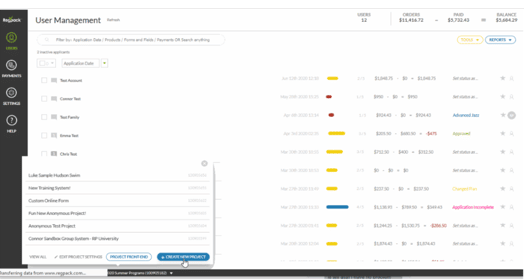
Source: Regpack
In short, Regpack allows you to organize an event, send out invitations via email or social media, and monitor registrations as they happen in real time.
On the day of the event, you can use Regpack’s check-in feature to track present and absent alumni and keep a record of their attendance.
Afterward, you can use Regpack’s reporting tools to analyze the attendance data to see how many alumni attended, how many are first-time attendees, and how many returning attendees.
This indicates where the alumni are on their engagement journey.
For instance, first-timers will generally need a softer and more informative approach, while those who show up repeatedly are likely ready to expand their engagement to volunteering, mentoring, or fundraising.
Overall, event attendance is an important metric that will enable you and your team to measure and increase engagement, as well as continually improve future events.
Volunteering Metrics
Volunteering metrics are used to measure the engagement of your former students in terms of the time they spend participating in different volunteer activities organized by your school.
Tracking this data allows you to better understand the level of alumni engagement in volunteering, determine what improvements can be made, and identify which alumni are ready to become more involved with their alma mater.
Of course, alumni volunteering activities will vary depending on the type, setup, and needs of your school (e.g., K-12 school, college, university), but they typically include:
- Helping with school events and fundraisers
- Participating in school committees, panels, and career fairs
- Mentoring current students
For example, here are the volunteering opportunities Swansea University (UK) offers to its alumni:

Source: Swansea University
As you can see, they offer many virtual volunteering opportunities, such as discussions, mentoring, and open-day talks combined with regular alumni lectures or guest speaking.
If you’re wondering what volunteering metrics to track, it’s a good idea to start with the number of alumni who expressed an interest in volunteering and the number of alumni who actually went through with it.
Of course, you should also track the amount of time they’ve spent volunteering, as well as the types of activities they’ve participated in.
Finally, don’t forget to ask your alumni volunteers for feedback directly or using surveys and online forms so you can measure their overall satisfaction with volunteering for your school.
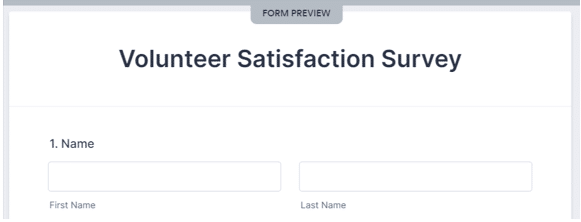
Source: Jotform
All these metrics are indicators of alumni engagement and give insights into what can be improved and which of your alumni might like to get involved more.
When the method of tracking is concerned, there are many specialized software tools for volunteer management available on the market, such as VolunteerHub and Volgistics.
However, schools looking for a more comprehensive solution that covers volunteer and alumni registration and management might again consider Regpack.
Overall, volunteering metrics are an important measure of alumni engagement that enables your school to understand what can be improved and identify alumni willing to expand their engagement.
Email Engagement
Another alumni engagement indicator your school should measure is how your former students interact with emails they receive from their alma mater.
This information can be used to determine what types of emails, such as newsletters, invitations to school events, online surveys, or donation requests, are best received by your alumni and how their engagement with school emails can be improved.
As for what can be tracked, various email tracking tools will provide a range of engagement metrics.
Among them, there are three core metrics that should be tracked:
- Open rate (how many emails were opened by the alumni)
- Response rate (how many alumni replied to an email or filled out a form)
- Click-through rate (how many alumni clicked on the links in the emails)
You can see these and other typical email engagement metrics in the image below, courtesy of Glock Apps:
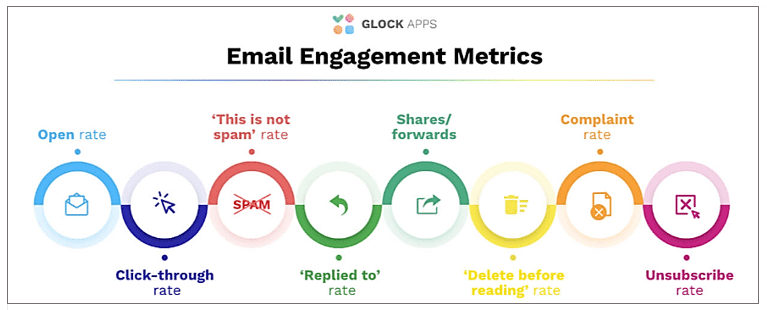
Source: Glock Apps
For instance, the “This is not spam” rate shows how many alumni found your school emails in their spam folder and marked them as “Not spam” so they would receive future emails in their inbox.
This action indicates they’re interested in following what’s going on with their former school and, therefore, are more likely to respond to event invitations or get involved in other ways.
Likewise, a potentially higher level of alumni engagement is also indicated by the rate of school emails an alum shared or forwarded.
The last three metrics shown above, such as the “Delete before reading” rate, are considered negative markers for alumni engagement, so other ways of reaching them should be explored, such as in-person outreach or social media.
Overall, email engagement metrics allow you to evaluate the effectiveness of your alumni email campaigns and determine how you can improve them to increase overall alumni engagement.
Social Media Participation
Social media participation (engagement) refers to how often alums interact with your school’s social media posts (likes, comments, shares, impressions) and how often they post their own school-related content on social media.
Like with emails, these metrics can be used to measure the level of interaction and engagement of your alumni with the school’s social media channels and their potential for further real-life involvement.
When analyzed, they become indicators that allow your alumni management team to gain insights about specific actions that can be taken to improve both online and offline alumni engagement.
As for how social media metrics are tracked, each social network has native analytics tools, such as Meta Business Suite (Facebook and Instagram), Twitter Analytics, or YouTube Analytics.
However, considering that your school might be using more than one social platform, it’s probably best to find an all-in-one software tool that has all your social media analytics in one place, such as Hootsuite.
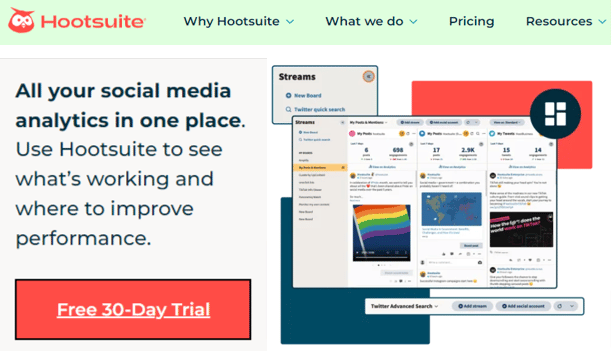
Source: Hootsuite
This tool allows you to track social media metrics from all platforms, analyze the data, and create custom reports, such as those focused on social media participation by your alumni.
For example, you can track your school’s social media mentions made by alumni, and you can use this data to tag their content, which shows them you appreciate their content and prompts them to respond and get involved further.
Likewise, you should monitor which of your former students share school-related content like photos, comments, links to news articles, and job or networking opportunities on social media.
That way, you get a list of alumni who are more likely to respond positively to getting involved in other ways, such as attending an event, volunteering, or donating.
To sum up, measuring the social media participation of your alumni provides valuable indicators of their level of engagement online and their potential readiness to expand their engagement to offline activities.
Survey Response Rate
The survey response rate is another useful indicator that tells you how many alumni responded to a survey sent out by your school.
When compared with the total number of alumni who were sent the survey, this metric indicates the general level of alumni engagement and allows you to assess the relevance of survey questions and the quality of your outreach efforts.
In turn, this enables you to make improvements, increase the response rate to future surveys, and identify opportunities for growing other forms of alumni engagement.
These opportunities stem from recording which alumni actually filled out the survey, which indicates it’s more likely they’ll respond to event invitations, volunteering, and donation requests.
As for increasing the survey response rate among your alumni, there are case studies, like this one by Fordham University, that give real-life examples of how that can be done.
For instance, said university simplified the survey structure and trimmed the number of questions, personalized the survey to make it more school-specific, and advertised it to fight survey fatigue.
However, the percentage of filled-out alumni surveys can vary widely depending on factors such as the subject matter of the survey, the timing and method of distribution, the total number of alumni, and their level of engagement.
For example, we highlighted the response rate for the Rhode Island School of Design (RISD) below.
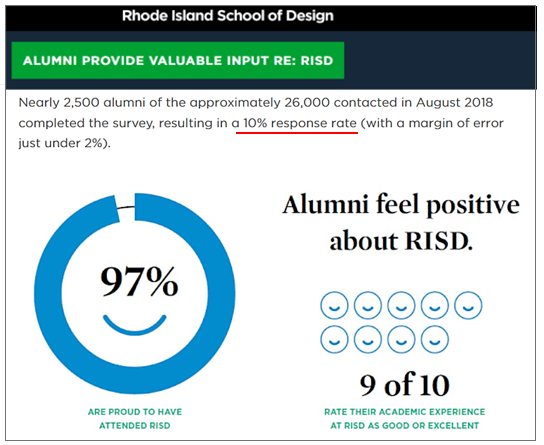
Source: RISD
Generally speaking, a higher response rate indicates that alumni are more engaged and interested in participating in other school activities.
Conversely, a lower response rate may indicate that alumni are not as engaged, so other ways and incentives for them to get involved should be considered.
As for the school in the above example, in addition to the valuable information collected, their survey generated a list of 2,500 alumni who are more likely to be interested in responding to other surveys, giving feedback, and participating in school events.
Overall, the survey response rate is another useful indicator that allows you to better understand the general level of alumni engagement, improve your survey-related practices, and identify alums with a potentially higher interest in further involvement with your school.
Conclusion
To summarize, an engaged and active alumni community is important, if not crucial, for the continued success of your school, as alumni are a great source of financial and logistical support.
In order to ensure your alumni get involved and stay engaged, your school should measure a range of engagement metrics.
When the metrics described here are combined, the insights gained from the collected data will enable your school to devise actions that will help maintain strong relationships with alumni and increase their engagement over time.


















